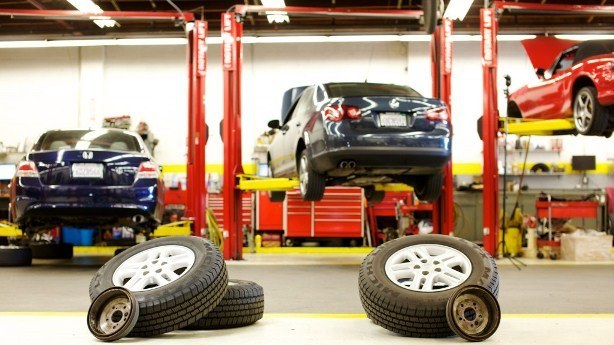All Categories
Featured

Preserving your car's tires is important to guarantee a smooth, safe, and reliable driving experience. 2 key solutions that are frequently forgotten yet have a significant influence on tire durability and performance are tire turning and alignment. These solutions aid keep your automobile running efficiently and protect against unequal tire wear that can impact both safety and fuel economic climate. Allow's study what tire rotation and positioning are and why they are essential for your auto.
What Is Tire Turning? Tire rotation is the process of relocating your tires from one placement to another to ensure they use equally. Considering that your cars and truck's tires operate at various rates relying on their position (front tires versus back tires), rotating them on a regular basis assists to disperse the wear equally, bring about a longer lifespan for your tires.
Tires on the front axle have a tendency to wear quicker than those on the back axle, especially in front-wheel-drive autos, where the front tires handle both steering and power. On the various other hand, back tires may put on erratically relying on the lorry's weight distribution and driving conditions. By revolving your tires every 6,000 to 8,000 miles (or as advised by the supplier), you'll make sure a more well balanced wear pattern.
What Is Tire Alignment? Tire placement, additionally referred to as wheel positioning, refers to readjusting the angles of your cars and truck's wheels to the producer's specifications. Appropriate alignment guarantees that your tires are aiming in the right direction, and it helps make the most of tire life and improve lorry handling. There are 3 main facets of alignment: camber, wheel, and toe.
Camber describes the tilt of the tires from the front of the automobile. If your tires are tilted excessive internal or outward, it can create irregular wear. Wheel describes the angle of the guiding axis when checked out from the side of the car. This impacts the security of the steering, especially when driving directly. Toe describes the angle at which the tires direct inward or outside when viewed from above. This affects exactly how your car tracks on the road. A proper alignment makes certain that all 4 tires are directing right ahead and are angled correctly. Misalignment can result from hitting potholes, aesthetics, or merely from the wear of suspension parts in time.
Why Tire Rotation and Positioning Matter. Extended Tire Life. Both tire rotation and alignment help protect against irregular tire wear. When your tires wear uniformly, they last longer, which can save you cash in the lengthy run by reducing the need for early replacements.
Improved Security. Correct tire rotation and positioning improve automobile security and handling. Misaligned tires or erratically used tires can negatively affect your ability to guide and stop your car, especially in emergency situation circumstances. Routine upkeep ensures your tires perform optimally, supplying a safer driving experience.
Better Gas Efficiency. If your tires are not straightened appropriately, they might drag versus the road surface area, causing resistance. This extra friction can reduce gas effectiveness, causing your automobile to take in more gas. Regular tire positioning makes certain that your automobile relocates efficiently, boosting gas mileage.
Boosted Convenience. Imbalance or unevenly worn tires can cause a rougher experience, as your vehicle may draw to one side or cause resonances. By keeping your tires turned and aligned, you'll enjoy a smoother and much more comfy driving experience.
Signs That Your Tires Need Turning or Alignment. It's crucial to stay sharp for any kind of indicators that your tires need turning or alignment. Keep an eye out for these typical indicators:
Uneven Tire Put On: If you see that tire is dramatically extra worn than the others, it might be time for a turning or positioning. Steering Pull: If your cars and truck pulls away while driving directly, this could indicate imbalance. Vibrations: If you feel resonances in the steering wheel or the cars and truck itself, maybe a sign of misalignment or irregular tire wear. Screeching Tires: Uncommon tire sound might additionally suggest incorrect placement or the demand for a tire rotation. How Typically Should You Revolve and Straighten Your Tires? Tire turning ought to generally be done every 6,000 to 8,000 miles or as specified in your vehicle's owner's guidebook. It's an excellent idea to revolve your tires during every oil modification, as this will help you remain on top of routine maintenance.
When it comes to alignment, it doesn't require as frequent service. Commonly, placement should be examined at least yearly or whenever you discover concerns like drawing away or vibration. You may likewise need placement if you have actually hit a large pocket or aesthetic, which can toss your wheels out of positioning.
Verdict: Maintain Your Tires in Leading Forming. Tire turning and alignment are crucial services that maintain your lorry running smoothly, securely, and efficiently. By taking the time to have your tires rotated and lined up on a regular basis, you're buying your cars and truck's efficiency and longevity, while likewise improving your safety when driving. Remain aggressive with tire maintenance, and your vehicle will thanks with much better gas economy, boosted handling, and extended tire life.
Latest Posts
Explore Montclare Auto Repair’s Most Popular Auto Repairs and Why Drivers Rely On Them
Find Oil Changes & More: Full Repair Options from Montclare Auto Repair
Get to Know Your Wyoming Banking Partner – Your Guide to Superior Financial Services in Wyoming
More
Latest Posts
Explore Montclare Auto Repair’s Most Popular Auto Repairs and Why Drivers Rely On Them
Find Oil Changes & More: Full Repair Options from Montclare Auto Repair
Get to Know Your Wyoming Banking Partner – Your Guide to Superior Financial Services in Wyoming